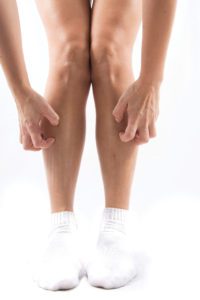By Joseph Magnant, MD, FACS, RPVI
 Each one of our patients has a unique struggle with vein disease and venous insufficiency–from swollen legs to endless leg cramps leading to the inability to continue with day-to-day activities. Mary Anne Simpson’s story is one of perseverance, of not accepting “no” for an answer, and of how she found Dr. Joseph Magnant who finally helped restore her health and sanity. As an active mother who plays tennis and works out several days a week, Simpson was suffering from chronic itchiness below the knees. Over time, the itching became intolerable, eventually resulting in a rash, which at times covered a large portion of her legs. She recalls that she had to wear long tights to play tennis because someone asked if the rash was contagious. The itching was so bad I felt like I was losing my mind.” It wasn’t just the physical discomfort that made her feel this way, but the number of different specialists she visited over nearly two years who told her there was nothing wrong with her or nothing they could do to help her. Simpson lives in the Chicago area and over the course of her disease, she spent thousands of dollars and saw numerous highly recommended physicians, who offered little to no relief or answers.
Each one of our patients has a unique struggle with vein disease and venous insufficiency–from swollen legs to endless leg cramps leading to the inability to continue with day-to-day activities. Mary Anne Simpson’s story is one of perseverance, of not accepting “no” for an answer, and of how she found Dr. Joseph Magnant who finally helped restore her health and sanity. As an active mother who plays tennis and works out several days a week, Simpson was suffering from chronic itchiness below the knees. Over time, the itching became intolerable, eventually resulting in a rash, which at times covered a large portion of her legs. She recalls that she had to wear long tights to play tennis because someone asked if the rash was contagious. The itching was so bad I felt like I was losing my mind.” It wasn’t just the physical discomfort that made her feel this way, but the number of different specialists she visited over nearly two years who told her there was nothing wrong with her or nothing they could do to help her. Simpson lives in the Chicago area and over the course of her disease, she spent thousands of dollars and saw numerous highly recommended physicians, who offered little to no relief or answers.
It turns out that what she was suffering from was “stasis dermatitis,” a skin condition that results when blood pools in the legs due to damaged valves within the veins. Stasis Dermatitis is an advanced stage of vein disease. Without any answers, she began to do some internet research on her symptoms. She even asked her physicians about the possibility of the rashes being related to vein disease, but the condition continued to go undiagnosed. According to Simpson, “I went to five different doctors who prescribed lots of expensive ointments and antibiotics, and one doctor even tried to treat me for fleas.”
Extensive allergy tests came back negative. She tried changing her diet, even making her own soap to avoid chemicals, but the itching persisted. “I thought I was going to suffer for the rest of my life. It sounds so trivial, but it was severely affecting my daily life.” During one of her worst flare-ups, she was on the internet and stumbled on an old blog about venous insufficiency and stasis dermatitis, written by Dr. Magnant. He explained, “Stasis dermatitis is a skin condition, but it’s a sign of an underlying venous problem.” The first stop for most people who are suffering from this is usually a dermatologist, who typically prescribes a steroid cream. Simpson says, “I was using steroid cream like a moisturizer.” The signs of stasis dermatitis are lower leg skin discoloration, and in some cases thickening skin. Other signs and symptoms may include red, swollen, and sometimes itchy lower legs. Without identifying and fixing the underlying problem the stasis dermatitis condition will often continue and eventually worsen.
Desperate for help, Simpson reached out to Vein Specialists and within weeks bought a plane ticket to Fort Myers from Chicago for an evaluation by Dr. Magnant. After nearly three hours of comprehensive ultrasound testing, she remembers, “I could tell by the face of the Vascular Technologist performing the ultrasound, that they found something abnormal. I felt like crying. I thought, oh my gosh, I DO have this and I’m NOT losing my mind.” She had a blockage in the left common iliac vein (a condition referred to as May Thurner Syndrome), and there was insufficiency in both & great saphenous veins (main leg veins). Over 2-3 months and several trips to Fort Myers, MaryAnne first underwent IVUS (Intravascular Ultrasound) of the pelvic veins where a stent was placed to open the blockage in the left iliac vein. She noted a significant improvement in her symptoms. However, based on the severity of the leaky veins in the legs,
Dr. Magnant also performed an Endovenous Ablation (heat sealing of the veins) of both of her legs, staged over 4-6 weeks.
So, why was it such a challenge to make the correct diagnosis?
Stasis dermatitis is often misdiagnosed as a dermatological disease (since it appears as a skin related problem) and as the problem worsens patients may end up at a dermatologist, allergist, or wound care physician’s office. For this reason, Dr. Magnant dedicates much of his time educating other physicians on how vein disease often intersects with dermatology in what he has coined “DERMATO-VENOUS” disease.” Venous Insufficiency often progresses and manifests as people age, however, Dr. Magnant has treated patients of all ages with these problems, so Mary Anne at 60 was not an uncommon age to present with signs & symptoms of Vein Disease.
Simpson concludes, “I hope that my story will help other people out there who are like me, who feel they are suffering from something ‘undiagnosable’ or ”nonexistent’. Dr. Magnant gave me my life and my sanity back.”
Please visit our website at weknowveins.com or contact us by phone at 239-694-VEIN (8346).
1500 Royal Palm Square Blvd., Suite 105, Fort Myers, Florida | 3359 Woods Edge Circle, Suite 102, Bonita Springs, Florida









